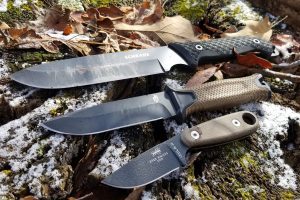How to select A Knife For Outdoor Sports

The first thing you should determine is what you’ll be using the knife for – will it be for camping survival, hunting, defence or some other activity? Once you’ve decided what activities you plan to use the knife for, you can determine what features you need the knife to have.
Best selling outdoor knives
Last update on 2024-10-15 / Affiliate links / Images from Amazon Product Advertising API
See a selection of outdoors knives for sale
Each outdoor activity requires a specific set of features. Here are some common outdoor activities, along with suggested features that you might need.
Hunting: A hunting knife will need to have a blade shape suitable for skinning animals. The size of the knife will be largely determined by the game you are hunting.
Boating: A knife for boating will need to be stainless steel, to resist corrosion. The knife should be sharp, and you’ll probably want a partially serrated blade for cutting rope.
Fishing: You will probably want two separate knives for fishing – a fillet knife and a general purpose knife. The general purpose knife should be a small to medium knife with a stainless steel blade.
Survival: A survival knife should ideally be a large, very tough knife. It should be highly resistant to rust, and tough enough to handle a lot of abuse. If you’re stranded in the wilderness, you’re not likely to be able to take care of your knife very well, plus you may need to do things with it that you normally wouldn’t.
Camping: There is probably not one perfect camping knife. You’ll have to make a choice based on the type of camping you do, as well as what other tools you have, such as a machete, saw, or axe.
- You always want to be sure that the knife you pick is suitable for the activity you plan to use it for.
- When choosing a knife, it helps a lot to know what some of the features are, and what different materials and specs mean – in plain English.
- One of the most important materials in a knife is what steel the blade is made of.
- One popular steel used in knives is 420HC . This is a stainless steel with good abrasion resistance and it holds an edge well.
- 1095 Carbon Steel is another knife steel, often used with larger knives, as it is relatively economical. This steel performs well, as long as corrosion is not an issue.
- 440A, 440B, & 440C are all steels with excellent corrosion resistance. 440C is general considered the best steel, and 440A the lesser of the three. That doesn’t always hold true, though. With excellent heat treating, knives of 440A can be excellent knives (take the SOG Navy Seal knife, for example).
The AUS-6 – AUS-8 – AUS-10 steels are roughly equivalent to the 440 family of steels.
Another important consideration in choosing a knife is the handle type.
Handles materials can be broken down into three categories: Natural materials, Synthetic materials, and Non-slip materials. Natural materials generally have good looks, but they are generally not well suited to harsh conditions. If you plan to use your knife in wet conditions, you’ll probably want a synthetic non-slip handle.
The carry system is another feature to consider. Most fixed blade knives come with a sheath to carry the knife on your belt. Folding blade knives may come with a belt clip, sheath, both, or no carry system. Some knives also come with specialty sheaths that allow you to carry the knife on your leg, ankle, arm, etc.
All in all, there are many different factors that you should consider when buying a knife. Be sure that you carefully consider exactly what you need in a knife, so that you can find a knife that perfectly meets your needs!
Last Updated on September 15, 2024



